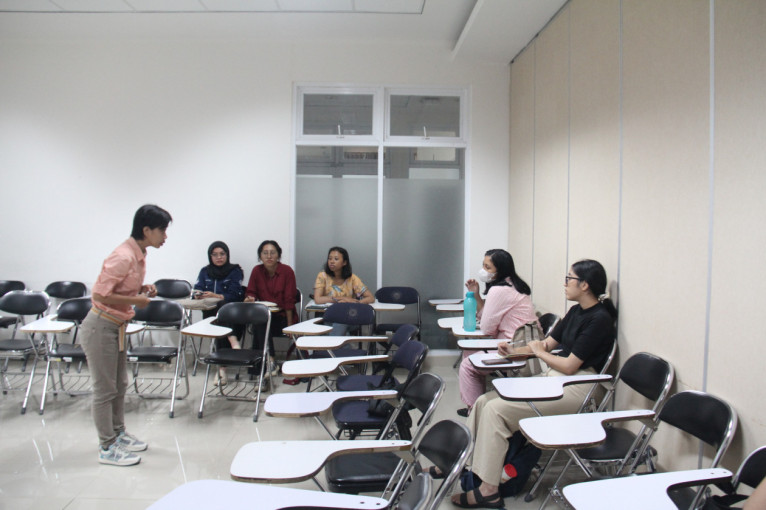
UGM has developed seven language literacy modules, six of which were used as teaching materials in the elective foreign language course curriculum in the odd semester of 2022.
The initial six modules crafted in the first batch include the English language module, French language module, Korean Language Module, Japanese Language Module, Turkish language module, and Arabic language module.
An additional module was added in the second batch, the Mandarin language module, introduced in the even semester of 2023.
“The language literacy modules are now complete. In the current even semester of 2023, all seven modules have been utilized as teaching materials in the interdisciplinary course curriculum,” stated Dr. Endang Sulastri, the Head of the Subdirectorate for Education and Teaching Development, UGM Directorate of Education and Teaching.
Dr. Sulastri explained that these modules are made available each semester to undergraduate and applied undergraduate students as part of the elective course curriculum for foreign languages.
Mastering foreign languages is an essential aspect of enhancing personal value, particularly among students.
Furthermore, she emphasized that students, as future intellectuals and young scholars in Indonesia, can directly apply the knowledge they acquire in the workforce and when engaging with the community if they are proficient in foreign languages.
Language fluency among the younger generation is also expected to enhance the nation’s competitiveness.
Dr. Sulastri reported that the student’s interest in language literacy exceeded expectations. Six hundred ten students were recorded in the first batch, and the number dramatically increased to 1052 individuals in the second batch.
“The surge in interest indicates that students are highly enthusiastic about learning foreign languages,” she remarked.
Frida Anis Handayani, one of the Mandarin language instructors, highlighted the diversity of the content presented in the language literacy modules.
Specifically, for the Mandarin language module she teaches, the material was curated by a team with diverse backgrounds, namely Mandarin journalism, Mandarin business, and Mandarin language education.
“The material presented in the module differs from that of other foreign language modules. While the other language modules introduce the native culture of the respective foreign language, the material we’ve developed focuses on Indonesian culture,” Handayani explained.
Handayani mentioned that this differentiation aims to enable students to introduce Indonesian culture when interacting with students or individuals from China.
The delivery is based on the cultural differences between the two countries, empowering students to know what to do when they are with people from China or Taiwan.
Handayani added that the Mandarin language module is designed to meet basic language needs. It instructs students on how to greet someone, address individuals, families, or friends, and pronounce numbers and prices, among other things.
The objective of this learning is to sharpen students’ insights into the Indonesian-Chinese cultural comparison and equip them to discuss topics in accordance with Mandarin language rules (pronunciation, grammar, sentence structure, and Chinese characters).
Moreover, the module is easy to apply for teaching language literacy to students since it includes a table encompassing essential words in Mandarin pronunciation.
“By mastering the basic words in that table, students will find it easy to apply Mandarin words or sentences,” she stated.
Handayani hopes that Mandarin language learning can be complemented with audiovisual aids so that students can learn Mandarin anywhere they are. By doing so, students will learn Mandarin more swiftly.
She added that the Mandarin module’s vocabulary is elementary, meaning students have yet to develop their Mandarin proficiency fully. Therefore, if there are supporting tools available during teaching that facilitate Mandarin learning, such as audiovisual media, it would be highly beneficial.
On the other hand, Wulan Tri Astuti, a French language instructor, expressed that the current French language literacy module fulfills the four aspects of language skills: listening, reading, speaking, and writing.
Notably, this module incorporates listening material appropriate for beginners. It is accompanied by brief explanations of grammar in English and French, making it easier for students to understand grammar rules.
“This module is at an easy level, suitable for first-level French learners or those at the European language standard A1.1. Moreover, it is easy to apply for French language learning as it has been designed based on language education standards using an active communication model,” Astuti detailed.
Despite this, Astuti recommended that future language literacy modules include independent study segments for students and additional information on module usage in each session. Also, the fourth module should be structured similarly to the other modules.
Adiba Qonita Zahroh, an English language instructor, stated that the module entitled “English for Academic Writing and Presentation” is compelling because it integrates writing and speaking skills within an academic context.
Additionally, it guides students in understanding the structure and conventions of academic writing.
“It focuses on interactive and practical learning through exercises and relevant tasks, allowing students a real opportunity to improve their English language skills and encourage critical thinking and effective argumentation,” she added.
Zahroh observed a significant increase in students’ abilities to write and speak in English within an academic environment after using this module.
The difficulty level can be adapted to students’ needs, making the learning process more effective and efficient. The module provides clear guidance, concrete examples, and exercises that support comprehension.
“This feature makes the module user-friendly and enables teachers to provide quality education to students,” Zahroh noted.
Additionally, the module’s flexibility enables its application to students from various programs and academic years. She hopes the English language literacy module can include more diverse case examples to help students understand concepts and their applications.
It is also essential to add complex exercises with detailed solutions to enhance students’ grasp of the material. Moreover, supplementary learning sources such as books, articles, or updated videos are also needed to assist students who wish to delve deeper into specific topics.
“This could also motivate them to explore English in an academic context more deeply,” Zahroh concluded.
Author: Listi
Editor: Ika

